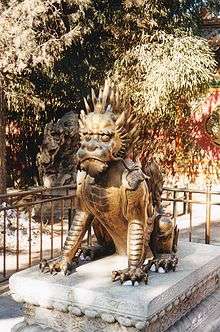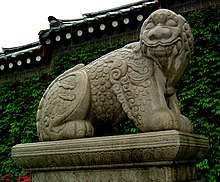Xiezhi
The xiezhi (Chinese: 獬豸 xièzhì) or haetae (Korean: 해태, often spelled haitai or haechi) is a legendary creature in East Asian mythology (Northern Chinese, Japanese, and Korean mythology).

| Part of a series on |
| Chinese folk religion |
|---|
 |
|
Theory
Model humanity: |
|
Institutions and temples |
|
Internal traditions Major cultural forms
Main philosophical traditions: Ritual traditions: Devotional traditions: Zhenkong, "Void of Truth". Confucian churches and sects:
|
|
Related religions
|
China
According to the legend, Emperor Shun's minister Gao Yao had a mythical, goat-like creature called the zhi (廌) which he used in criminal proceedings whenever he was in doubt. The animal instinctively knew the innocent from the guilty; it butted the latter with its single horn.[1]
Mentions of the xiezhi in Chinese literature can be traced back to the Han Dynasty where it is described by the scholar Yang Fu as a "righteous beast, which rams the wrongful party when it sees a fight and bites the wrongful party when it hears an argument". It is described in the Shuowen Jiezi as being "a cattle-like beast with one horn; in ancient times. It settled disputes by ramming the party at fault".
As an inherently just beast, the xiezhi was used as a symbol of justice and law. The Censorate of the Ming and Qing eras, who were responsible for the monitoring of the civil service, wore the xiezhi as a badge of office. Similarly, military policemen of the Republic of China wear badges bearing the xiezhi and it is engraved on the gavels in the law courts of the People's Republic of China.
Japan
In Japan, it is known as kaichi (獬豸), also sometimes referred to as a shin'yō (神羊 "divine sheep"). It is similar to a lion with one horn on the top of its head.[2]
Korea

The xiezhi is known as haetae in Korea. According to Korean records, Haetae's body is muscular and shaped like a lion and has a horn on its forehead. It has a bell in its neck and the body is covered with sharp scales. It lives in the frontier areas of Manchuria.[3]
In ancient Korea, Haetae sculptures were used in architecture during the early Joseon dynasty as their image was trusted to be able to protect Hanyang (now Seoul) from natural disasters and to give law and order among the populace. In Korea, haetae is a mythical beast that prevents fire disaster. To prevent fire in Gyeongbok palace, haetae sculpture was placed in front of the palace. Seoul city has officially used Haechi (origin of Haetae) as the symbol of Seoul since 2009.
In English, it is called "the unicorn-lion" or "an omniscient mythical beast".
In popular culture
- The 2019 Korean drama Haechi has the namesake creature as motif for the characters.
See also
References
- Jeannie Thomas Parker, The Mythic Chinese Unicorn, http://chinese-unicorn.com/ch01/
- Gould, Charles (2009). Mythical Monsters. BiblioLife. pp. 357–359. ISBN 0-559-10836-2.
- An Illustrated Guide to Korean Culture - 233 traditional key words by The National Academy of the Korean Language
External links
| Wikimedia Commons has media related to Xiezhi. |
